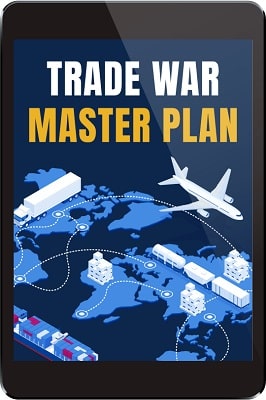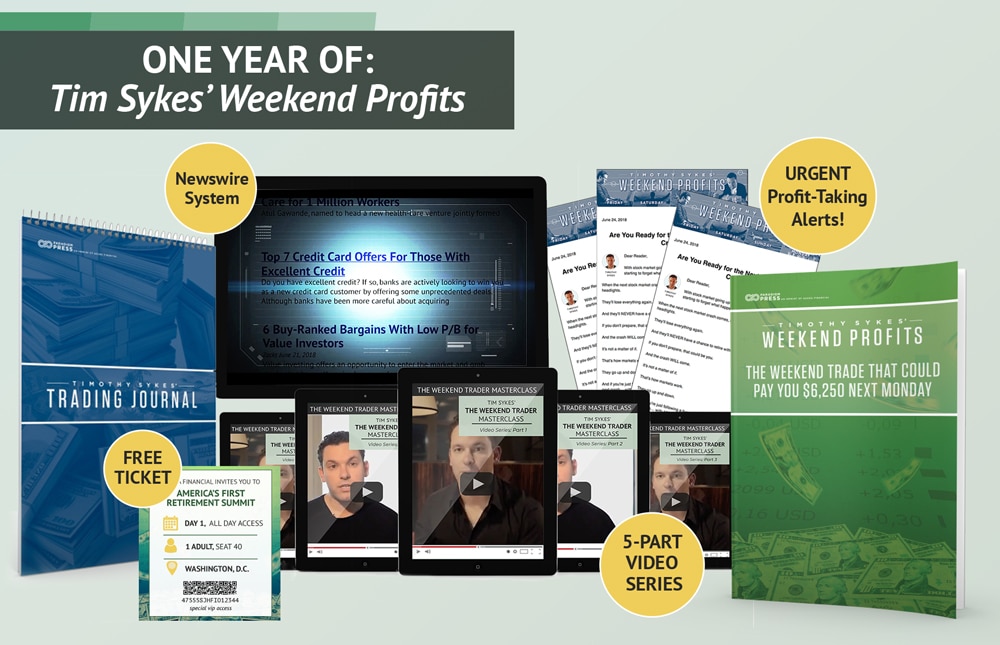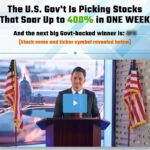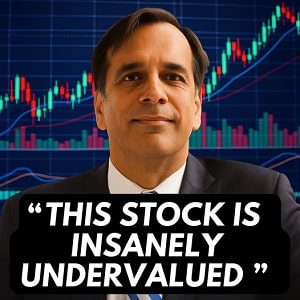Donald Trump’s recent tariff announcements have sent shockwaves through global markets, triggering what some call the largest two-day stock market loss in history, with a staggering $5 trillion wiped out. Mainstream media outlets like The New York Times and The Washington Post have painted a grim picture, warning of economic catastrophe. Academics, including University of Michigan’s Justin Wolfers and former Treasury Secretary Larry Summers, have labeled the tariffs “monstrously destructive.”
Yet, Shah Gilani, a 40-year Wall Street veteran, proposes a provocative theory: this chaos is not an accident but a deliberate, genius strategy by Trump to reshape America’s economic landscape. In his detailed analysis, Gilani outlines a four-step “Master Plan” that he claims could make American patriots millionaires while punishing Trump’s detractors. But is this plan legitimate, or is it an overzealous interpretation of market volatility? This article dissects Gilani’s theory, evaluates its plausibility, and explores the potential risks and rewards for investors.
Who is Shah Gilani?
 Shah Gilani is a seasoned financial analyst with a degree in economics and psychology from the same institution as notable figures like Jim Simons and Larry Fink.
Shah Gilani is a seasoned financial analyst with a degree in economics and psychology from the same institution as notable figures like Jim Simons and Larry Fink.
With 40 years of Wall Street experience, Gilani claims to have played a role in developing the CBOE Volatility Index, a tool used globally by traders to gauge market volatility. His track record includes prescient calls, such as warning investors to sell before the 2008 financial crisis and advising them to buy back in at the market bottom in 2009.
Gilani’s expertise lies in spotting big trends and profiting from volatility, which forms the basis of his analysis of Trump’s trade war strategy. His newsletter, Manward Money Report, aims to guide investors through turbulent markets, and his current focus is on what he sees as a historic opportunity created by Trump’s policies.
The Market Chaos: Context and Reaction
Trump’s tariff plan, announced recently, has led to unprecedented market turbulence. The $5 trillion loss over two days has been described as the largest in history, surpassing even the 1987 crash.
Media outlets have reacted with alarm, with headlines suggesting irreversible damage to the American economy. Academic critics have echoed these sentiments, with Summers claiming that Trump’s rhetoric alone has cost Americans dearly.
Social media platforms, particularly X, have been abuzz with speculation, including a video where Trump allegedly hinted at intentionally crashing the market. Amid this panic, Gilani argues that the chaos is a calculated move, part of a broader strategy to reset the economy and create wealth-building opportunities for Trump’s supporters.
Gilani’s Four-Step Master Plan
Gilani’s theory hinges on a four-step plan that he believes Trump is executing with precision, drawing from principles outlined in Trump’s book, The Art of the Deal. Below, we break down each step, analyze its components, and assess its feasibility.
Step 1: Create Chaos in the Stock Market
Gilani’s Claim: Trump deliberately triggered a stock market crash to reset asset prices, making stocks, energy, and housing more affordable for Americans.
This “grenade” approach aims to lower energy prices, reduce mortgage rates, and bring stock valuations to levels accessible to regular investors. Gilani suggests Trump is using this chaos to refill the Strategic Petroleum Reserve at lower costs and establish a U.S. Sovereign Wealth Fund by buying undervalued assets.
Analysis: The idea that a president would intentionally crash the market is bold and controversial. Historical data shows that market crashes often lead to buying opportunities, as seen during the 2008 financial crisis and the 2020 COVID-19 crash.
Lower energy prices and mortgage rates could indeed benefit consumers, and refilling the Strategic Petroleum Reserve at lower oil prices is economically sound. However, the risks are significant. A prolonged market downturn could trigger a recession, erode consumer confidence, and devastate retirement accounts.
The concept of a Sovereign Wealth Fund is intriguing, but its implementation would require congressional approval and careful management to avoid politicization. While Trump’s tariff announcements have undeniably caused volatility, attributing the entire crash to a deliberate strategy requires a leap of faith, as market reactions are influenced by multiple factors, including global trade dynamics and investor sentiment.
Feasibility: Possible but risky. The short-term pain of a market crash could yield long-term benefits if managed correctly, but the political and economic fallout could be severe if the recovery is delayed.
Step 2: Force Federal Reserve Rate Cuts
Gilani’s Claim: By creating market panic, Trump is pressuring the Federal Reserve to cut interest rates, potentially as early as May 6, 2025. Lower rates would reduce the $900 billion annual interest payments on the national debt, stabilize markets, and lower borrowing costs for Americans, particularly for mortgages. Gilani cites a recent 20-point drop in mortgage rates as evidence of this strategy’s early success.
Analysis: High interest rates, driven by inflation during the Biden administration, have indeed strained the federal budget, with interest payments surpassing defense spending.
A market crash could force the Fed to act swiftly to prevent a deeper economic crisis, as seen during the 2008 and 2020 downturns. Recent data indicates inflation has fallen to its lowest level in four years, creating room for rate cuts.
However, the Fed operates independently, and Chairman Jerome Powell has emphasized data-driven decisions over political pressure. While Trump’s public calls for rate cuts may amplify market expectations, the Fed’s actions will likely depend on economic indicators like unemployment and inflation. The 20-point mortgage rate drop is notable, but such fluctuations are common during volatile periods and may not directly result from Trump’s actions.
Feasibility: Likely. The Fed may cut rates in response to market instability, but the timing and magnitude depend on broader economic conditions, not solely Trump’s influence.
Step 3: Secure Favorable Trade Deals
Gilani’s Claim: The global market downturn has weakened foreign economies, giving Trump leverage to negotiate trade deals that favor the U.S.
Gilani points to 75 countries, including Vietnam and the EU, expressing willingness to negotiate, driven by fear of losing access to the U.S. market. These deals, combined with low interest rates, will create a robust business environment, driving stock market recovery.
Analysis: Trump’s first term demonstrated his ability to renegotiate trade agreements, such as the USMCA, which replaced NAFTA. The current tariff threats have indeed prompted responses from trading partners, with Vietnam offering zero tariffs and the EU signaling openness to talks.
Data from the U.S. Trade Representative shows that trade deficits with key partners like China have persisted, suggesting room for improvement. However, trade negotiations are complex and time-consuming, and foreign governments may resist concessions that harm their domestic industries. The global economic interdependence means that prolonged trade wars could hurt U.S. exporters and consumers through higher prices. While Trump’s leverage is real, the success of this step depends on diplomatic skill and the willingness of other nations to compromise.
Feasibility: Probable. Trump’s aggressive stance could yield better trade terms, but the process may be slower and more contentious than Gilani suggests.
Step 4: Implement Massive Tax Cuts
Gilani’s Claim: Trump will use savings from reduced spending, lower interest payments, and tariff revenues to fund significant personal and corporate tax cuts. These cuts, similar to those in 2017, will boost consumer spending, corporate earnings, and stock prices, creating a “rip-roaring” bull market. Gilani cites historical examples like Plug Power (2,480% gain) and Enphase Energy (7,780% gain) to illustrate potential returns.
Analysis: The 2017 Tax Cuts and Jobs Act did spur economic growth, with the Nasdaq nearly doubling in three years. Corporate tax cuts increased earnings, driving stock prices higher, while individual tax cuts boosted consumer spending. Current proposals, including Trump’s work with Elon Musk’s DOGE initiative to cut government waste, could free up funds for tax relief.
However, the national debt, now at $36 trillion, poses a challenge. Large-scale tax cuts without corresponding spending reductions could exacerbate deficits, potentially offsetting the benefits of lower interest payments. The stock market’s response to tax cuts is well-documented, but the magnitude of gains cited by Gilani (e.g., 7,780%) is exceptional and not guaranteed. Political opposition in Congress could also delay or dilute tax cut proposals.
Feasibility: Possible. Tax cuts are a cornerstone of Trump’s economic agenda, but their scale and impact depend on fiscal constraints and political dynamics.
Investment Opportunities: Gilani’s Recommendations
Gilani proposes three immediate investment opportunities to capitalize on Trump’s plan, detailed in his Trade War Master Plan report:

-
Rare Earth Metals Company: A U.S.-based firm with the only integrated rare earth mining and processing facility, poised to benefit from Trump’s push to reduce reliance on China. Trading at $20 per share, Gilani sees it reaching $100 or more, with “100-bagger potential.”
-
Steel Industry Player: A metallurgic coal producer essential for steel production, currently at $11 per share, down from $45 during Trump’s first term. Gilani predicts a potential 10x return as Trump prioritizes American steel.
-
AI Growth Stock: An Agentic AI company with partnerships across major tech firms, trading at $10 with 1,000% upside potential due to its role in automation and AI-driven industries.
Analysis: These sectors align with Trump’s stated priorities. The U.S. Geological Survey confirms China’s dominance in rare earths (70% of production), and Trump’s tariffs could spur domestic investment.
The steel industry has benefited from past protectionist policies, with the American Iron and Steel Institute reporting job growth under Trump’s first-term tariffs.
The AI sector is booming, with McKinsey projecting $15.7 trillion in global economic impact by 2030. However, these investments carry risks.
Rare earth mining faces environmental and regulatory hurdles, steel is cyclical and sensitive to global demand, and AI stocks are volatile, with high valuations in some cases. Gilani’s price targets are ambitious and assume a best-case scenario for Trump’s plan.
Critiques and Risks
While Gilani’s theory is compelling, it faces several challenges:
-
Overattribution: The market crash may result from broader factors, such as global trade fears or algorithmic trading, rather than a deliberate Trump strategy.
-
Economic Fallout: A prolonged downturn could lead to unemployment, reduced consumer spending, and a recession, undermining Trump’s goals.
-
Political Resistance: Congress, the Fed, and foreign governments may not align with Trump’s timeline or objectives, delaying key steps like tax cuts or trade deals.
-
Speculative Investments: Gilani’s stock picks, while promising, are high-risk, and his projected returns (e.g., 7,000%) are outliers, not norms.
-
Bias: Gilani’s alignment with Trump’s rhetoric and his promotional tone (e.g., urging immediate action) suggest a potential bias toward sensationalism to drive newsletter subscriptions.
The Bigger Picture: Economic and Political Implications
If Gilani’s theory holds, Trump’s plan could address critical issues: reducing the $36 trillion national debt, reversing unfavorable trade deals, and lowering living costs.
The creation of a Sovereign Wealth Fund, if executed transparently, could diversify government revenue and fund public goods. However, the strategy’s success hinges on precise execution and favorable external conditions, such as global economic stability and domestic political support. The plan also raises ethical questions about intentionally inducing market chaos, which could disproportionately harm vulnerable investors while benefiting those who act quickly, as Gilani advises.
Should You Act Now?
Gilani’s call to “act now” is driven by his belief that stocks are at historic lows, with catalysts like rate cuts and trade deals imminent.
Historical data supports the idea that buying during crashes can yield significant returns—those who invested in the S&P 500 at the 2009 bottom saw 400% gains over a decade.
However, timing the market is notoriously difficult, and Gilani’s May 6, 2025, prediction for a Fed rate cut is speculative. Investors must weigh the potential rewards against the risks of further volatility. Diversification, risk tolerance, and consultation with a financial advisor are crucial before making moves based on Gilani’s recommendations.
Conclusion
Shah Gilani’s theory that Trump’s trade war is a deliberate, four-step Master Plan to enrich America is a bold hypothesis that blends economic analysis with political strategy.
By creating market chaos, forcing rate cuts, securing trade deals, and implementing tax cuts, Trump could, in theory, reset the economy and create unprecedented wealth-building opportunities.
Gilani’s investment picks in rare earths, steel, and AI align with Trump’s priorities and offer high-upside potential, but they come with significant risks. While elements of the plan are feasible, its success depends on numerous variables, including global cooperation and domestic political will.
Investors intrigued by Gilani’s analysis should approach with caution, balancing optimism with a clear-eyed assessment of the risks. Whether Trump’s trade war is a “genius move” or a high-stakes gamble remains to be seen, but it has undeniably set the stage for a transformative moment in American economic history.
FAQ: Shah Gilani’s Trump’s Trade War Master Plan
<!– wp:wpseopress/faq-block-v2 {"schema":{"@context":"https://schema.org","@type":"FAQPage","url":"https://steadyincomeinvestments.com/shah-gilani-trump-trade-war-master-plan/","@id":"https://steadyincomeinvestments.com/shah-gilani-trump-trade-war-master-plan/","mainEntity":[{"@type":"Question","url":"https://steadyincomeinvestments.com/shah-gilani-trump-trade-war-master-plan/#what-is-shah-gilanis-trumps-trade-war-master-plan","name":"What is Shah Gilani's Trump's Trade War Master Plan?","acceptedAnswer":{"@type":"Answer","answerCount":1,"text":"\u003cp\u003eShah Gilani proposes that Donald Trump's recent tariff announcements and the resulting $5 trillion market crash are part of a deliberate four-step strategy to reset the U.S. economy. The plan involves creating market chaos, forcing Federal Reserve rate cuts, securing favorable trade deals, and implementing massive tax cuts to enrich Americans and address issues like national debt and trade imbalances.\u003c/p\u003e"}},{"@type":"Question","url":"https://steadyincomeinvestments.com/shah-gilani-trump-trade-war-master-plan/#who-is-shah-gilani","name":"Who is Shah Gilani?","acceptedAnswer":{"@type":"Answer","answerCount":1,"text":"\u003cp\u003eShah Gilani is a 40-year Wall Street veteran with a degree in economics and psychology. He claims to have contributed to the CBOE Volatility Index and has a track record of accurate market predictions, such as warning investors before the 2008 crash. He runs the \u003cem\u003eManward Money Report\u003c/em\u003e newsletter, offering investment advice.\u003c/p\u003e"}},{"@type":"Question","url":"https://steadyincomeinvestments.com/shah-gilani-trump-trade-war-master-plan/#is-there-evidence-that-trump-intentionally-crashed-the-market","name":"Is there evidence that Trump intentionally crashed the market?","acceptedAnswer":{"@type":"Answer","answerCount":1,"text":"\u003cp\u003eGilani cites a video on X where Trump allegedly hinted at crashing the market \u0022on purpose\u0022 and a Truth Social post encouraging followers to seize wealth-building opportunities. However, market crashes are influenced by multiple factors, and no definitive evidence confirms Trump's intent. The theory remains speculative.\u003c/p\u003e"}},{"@type":"Question","url":"https://steadyincomeinvestments.com/shah-gilani-trump-trade-war-master-plan/#what-are-the-four-steps-of-trumps-master-plan-according-to-gilani","name":"What are the four steps of Trump’s Master Plan according to Gilani?","acceptedAnswer":{"@type":"Answer","answerCount":1,"text":"\u003cp\u003e\u003cstrong\u003eStep 1\u003c/strong\u003e: Create market chaos to lower stock, energy, and housing prices, enabling affordable investments and strategic purchases like refilling the Strategic Petroleum Reserve.\u003c/p\u003e\u003cp\u003e\u003cstrong\u003eStep 2\u003c/strong\u003e: Force the Federal Reserve to cut interest rates to reduce national debt interest payments and lower borrowing costs for Americans.\u003c/p\u003e\u003cp\u003e\u003cstrong\u003eStep 3\u003c/strong\u003e: Use global market weakness to negotiate trade deals favoring the U.S., boosting the economy.\u003c/p\u003e\u003cp\u003e\u003cstrong\u003eStep 4\u003c/strong\u003e: Implement personal and corporate tax cuts to fuel a bull market and increase national wealth.\u003c/p\u003e"}},{"@type":"Question","url":"https://steadyincomeinvestments.com/shah-gilani-trump-trade-war-master-plan/#what-investments-does-gilani-recommend","name":"What investments does Gilani recommend?","acceptedAnswer":{"@type":"Answer","answerCount":1,"text":"\u003cp\u003eGilani recommends three stocks in his \u003cem\u003eTrade War Master Plan\u003c/em\u003e report:\u003c/p\u003e\u003cul class=\u0022wp-block-list\u0022\u003e\u003c!\u002d\u002d wp:list-item \u002d\u002d\u003e\n\u003cli\u003eA U.S. rare earth metals company to counter China’s monopoly.\u003c/li\u003e\n\u003c!\u002d\u002d /wp:list-item \u002d\u002d\u003e\u003c/ul\u003e\u003cul class=\u0022wp-block-list\u0022\u003e\u003c!\u002d\u002d wp:list-item \u002d\u002d\u003e\n\u003cli\u003eA metallurgic coal producer supporting American steel.\u003c/li\u003e\n\u003c!\u002d\u002d /wp:list-item \u002d\u002d\u003e\n\n\u003c!\u002d\u002d wp:list-item \u002d\u002d\u003e\n\u003cli\u003eAn AI company specializing in Agentic AI systems.\u003c/li\u003e\n\u003c!\u002d\u002d /wp:list-item \u002d\u002d\u003e\n\n\u003c!\u002d\u002d wp:list-item \u002d\u002d\u003e\n\u003cli\u003eHe also offers bonus reports on nuclear energy and AI investments, emphasizing their high-growth potential.\u003c/li\u003e\n\u003c!\u002d\u002d /wp:list-item \u002d\u002d\u003e\u003c/ul\u003e"}},{"@type":"Question","url":"https://steadyincomeinvestments.com/shah-gilani-trump-trade-war-master-plan/#is-gilanis-plan-legitimate","name":"Is Gilani’s plan legitimate?","acceptedAnswer":{"@type":"Answer","answerCount":1,"text":"\u003cp\u003eThe plan is plausible in parts, as tariffs can influence markets, and Trump has prioritized trade reform and tax cuts. However, intentionally crashing the market is risky and controversial, and the plan’s success depends on unpredictable factors like global cooperation and political support. Critics argue Gilani’s optimistic projections may oversimplify complex economic dynamics.\u003c/p\u003e"}},{"@type":"Question","url":"https://steadyincomeinvestments.com/shah-gilani-trump-trade-war-master-plan/#what-are-the-risks-of-following-gilanis-advice","name":"What are the risks of following Gilani’s advice?","acceptedAnswer":{"@type":"Answer","answerCount":1,"text":"\u003cul class=\u0022wp-block-list\u0022\u003e\u003c!\u002d\u002d wp:list-item \u002d\u002d\u003e\n\u003cli\u003e\u003cstrong\u003eMarket Volatility\u003c/strong\u003e: Further downturns could lead to losses.\u003c/li\u003e\n\u003c!\u002d\u002d /wp:list-item \u002d\u002d\u003e\n\n\u003c!\u002d\u002d wp:list-item \u002d\u002d\u003e\n\u003cli\u003e\u003cstrong\u003eSpeculative Returns\u003c/strong\u003e: Gilani’s high return projections (e.g., 7,000%) are outliers, not guaranteed.\u003c/li\u003e\n\u003c!\u002d\u002d /wp:list-item \u002d\u002d\u003e\n\n\u003c!\u002d\u002d wp:list-item \u002d\u002d\u003e\n\u003cli\u003e\u003cstrong\u003eEconomic Fallout\u003c/strong\u003e: A prolonged crash could trigger a recession.\u003c/li\u003e\n\u003c!\u002d\u002d /wp:list-item \u002d\u002d\u003e\n\n\u003c!\u002d\u002d wp:list-item \u002d\u002d\u003e\n\u003cli\u003e\u003cstrong\u003eRegulatory Hurdles\u003c/strong\u003e: Sectors like rare earths face environmental and legal challenges.\u003c/li\u003e\n\u003c!\u002d\u002d /wp:list-item \u002d\u002d\u003e\n\n\u003c!\u002d\u002d wp:list-item \u002d\u002d\u003e\n\u003cli\u003e\u003cstrong\u003eBias\u003c/strong\u003e: Gilani’s promotional tone may prioritize newsletter subscriptions over objective analysis.\u003c/li\u003e\n\u003c!\u002d\u002d /wp:list-item \u002d\u002d\u003e\u003c/ul\u003e"}},{"@type":"Question","url":"https://steadyincomeinvestments.com/shah-gilani-trump-trade-war-master-plan/#should-i-invest-based-on-gilanis-recommendations","name":"Should I invest based on Gilani’s recommendations?","acceptedAnswer":{"@type":"Answer","answerCount":1,"text":"\u003cp\u003eGilani’s sectors (rare earths, steel, AI) align with Trump’s priorities, but investing carries risks. Historical data shows buying during crashes can yield gains, but timing is critical. Consult a financial advisor, assess your risk tolerance, and diversify investments before acting.\u003c/p\u003e"}},{"@type":"Question","url":"https://steadyincomeinvestments.com/shah-gilani-trump-trade-war-master-plan/#when-does-gilani-predict-the-federal-reserve-will-cut-rates","name":"When does Gilani predict the Federal Reserve will cut rates?","acceptedAnswer":{"@type":"Answer","answerCount":1,"text":"\u003cp\u003eGilani speculates an emergency rate cut could occur as early as May 6, 2025, due to market panic. However, the Fed’s decisions are data-driven, and this date is not confirmed.\u003c/p\u003e"}},{"@type":"Question","url":"https://steadyincomeinvestments.com/shah-gilani-trump-trade-war-master-plan/#how-can-i-access-gilanis-full-recommendations","name":"How can I access Gilani’s full recommendations?","acceptedAnswer":{"@type":"Answer","answerCount":1,"text":"\u003cp\u003eGilani offers his \u003cem\u003eTrade War Master Plan\u003c/em\u003e and bonus reports through a subscription to \u003cem\u003eManward Money Report\u003c/em\u003e, priced at $49 for a one-year trial (normally $249). The subscription includes monthly newsletters, stock picks, and a 365-day money-back guarantee.\u003c/p\u003e"}},{"@type":"Question","url":"https://steadyincomeinvestments.com/shah-gilani-trump-trade-war-master-plan/#what-is-the-u-s-sovereign-wealth-fund-gilani-mentions","name":"What is the U.S. Sovereign Wealth Fund Gilani mentions?","acceptedAnswer":{"@type":"Answer","answerCount":1,"text":"\u003cp\u003eGilani claims Trump plans to create a fund to invest in undervalued stocks, bonds, and assets during the market crash, aiming to generate wealth for the U.S. government. This idea is theoretical, as no official policy has been enacted, and implementation would require congressional approval.\u003c/p\u003e”}},{“@type”:”Question”,”url”:”https://steadyincomeinvestments.com/shah-gilani-trump-trade-war-master-plan/#can-trumps-plan-solve-the-national-debt-and-trade-issues”,”name”:”Can Trump’s plan solve the national debt and trade issues?”,”acceptedAnswer”:{“@type”:”Answer”,”answerCount”:1,”text”:”\u003cp\u003eThe plan could reduce debt interest payments and improve trade terms, but the $36 trillion national debt and complex global trade dynamics pose significant challenges. Tax cuts without spending reductions could increase deficits, and trade negotiations may face resistance.\u003c/p\u003e”}},{“@type”:”Question”,”url”:”https://steadyincomeinvestments.com/shah-gilani-trump-trade-war-master-plan/#is-this-a-good-time-to-invest-in-the-stock-market”,”name”:”Is this a good time to invest in the stock market?”,”acceptedAnswer”:{“@type”:”Answer”,”answerCount”:1,”text”:”\u003cp\u003eGilani argues that current low stock prices offer a historic buying opportunity, citing past recoveries after crashes. However, markets remain volatile, and investing now requires careful consideration of risks and long-term goals.\u003c/p\u003e”}},{“@type”:”Question”,”url”:”https://steadyincomeinvestments.com/shah-gilani-trump-trade-war-master-plan/#how-does-gilanis-plan-affect-average-americans”,”name”:”How does Gilani’s plan affect average Americans?”,”acceptedAnswer”:{“@type”:”Answer”,”answerCount”:1,”text”:”\u003cp\u003eIf successful, the plan could lower housing and borrowing costs, boost job creation in industries like steel, and increase investment returns. However, short-term market losses could harm retirement accounts, and economic disruption may affect vulnerable populations.\u003c/p\u003e”}},{“@type”:”Question”,”url”:”https://steadyincomeinvestments.com/shah-gilani-trump-trade-war-master-plan/#where-can-i-learn-more-about-trumps-economic-policies”,”name”:”Where can I learn more about Trump’s economic policies?”,”acceptedAnswer”:{“@type”:”Answer”,”answerCount”:1,”text”:”\u003cp\u003eFor official updates, check government websites like whitehouse.gov or follow credible news sources. For trade data, visit the U.S. Trade Representative’s site (ustr.gov). For Gilani’s insights, consider subscribing to \u003cem\u003e\u003cstrong\u003e\u003ca href=\u0022https://steadyincomeinvestments.com/ManwardMoneyReport\u0022 target=\u0022_blank\u0022 rel=\u0022noopener nofollow\u0022\u003eManward Money Report\u003c/a\u003e\u003c/strong\u003e\u003c/em\u003e.\u003c/p\u003e”}}]}} –>What is Shah Gilani’s Trump’s Trade War Master Plan?
Shah Gilani proposes that Donald Trump’s recent tariff announcements and the resulting $5 trillion market crash are part of a deliberate four-step strategy to reset the U.S. economy. The plan involves creating market chaos, forcing Federal Reserve rate cuts, securing favorable trade deals, and implementing massive tax cuts to enrich Americans and address issues like national debt and trade imbalances.
Who is Shah Gilani?
Shah Gilani is a 40-year Wall Street veteran with a degree in economics and psychology. He claims to have contributed to the CBOE Volatility Index and has a track record of accurate market predictions, such as warning investors before the 2008 crash. He runs the Manward Money Report newsletter, offering investment advice.
Is there evidence that Trump intentionally crashed the market?
Gilani cites a video on X where Trump allegedly hinted at crashing the market “on purpose” and a Truth Social post encouraging followers to seize wealth-building opportunities. However, market crashes are influenced by multiple factors, and no definitive evidence confirms Trump’s intent. The theory remains speculative.
What are the four steps of Trump’s Master Plan according to Gilani?
Step 1: Create market chaos to lower stock, energy, and housing prices, enabling affordable investments and strategic purchases like refilling the Strategic Petroleum Reserve.
Step 2: Force the Federal Reserve to cut interest rates to reduce national debt interest payments and lower borrowing costs for Americans.
Step 3: Use global market weakness to negotiate trade deals favoring the U.S., boosting the economy.
Step 4: Implement personal and corporate tax cuts to fuel a bull market and increase national wealth.
What investments does Gilani recommend?
Gilani recommends three stocks in his Trade War Master Plan report:
- A U.S. rare earth metals company to counter China’s monopoly.
- A metallurgic coal producer supporting American steel.
- An AI company specializing in Agentic AI systems.
- He also offers bonus reports on nuclear energy and AI investments, emphasizing their high-growth potential.
Is Gilani’s plan legitimate?
The plan is plausible in parts, as tariffs can influence markets, and Trump has prioritized trade reform and tax cuts. However, intentionally crashing the market is risky and controversial, and the plan’s success depends on unpredictable factors like global cooperation and political support. Critics argue Gilani’s optimistic projections may oversimplify complex economic dynamics.
What are the risks of following Gilani’s advice?
- Market Volatility: Further downturns could lead to losses.
- Speculative Returns: Gilani’s high return projections (e.g., 7,000%) are outliers, not guaranteed.
- Economic Fallout: A prolonged crash could trigger a recession.
- Regulatory Hurdles: Sectors like rare earths face environmental and legal challenges.
- Bias: Gilani’s promotional tone may prioritize newsletter subscriptions over objective analysis.
Should I invest based on Gilani’s recommendations?
Gilani’s sectors (rare earths, steel, AI) align with Trump’s priorities, but investing carries risks. Historical data shows buying during crashes can yield gains, but timing is critical. Consult a financial advisor, assess your risk tolerance, and diversify investments before acting.
When does Gilani predict the Federal Reserve will cut rates?
Gilani speculates an emergency rate cut could occur as early as May 6, 2025, due to market panic. However, the Fed’s decisions are data-driven, and this date is not confirmed.
How can I access Gilani’s full recommendations?
Gilani offers his Trade War Master Plan and bonus reports through a subscription to Manward Money Report, priced at $49 for a one-year trial (normally $249). The subscription includes monthly newsletters, stock picks, and a 365-day money-back guarantee.
What is the U.S. Sovereign Wealth Fund Gilani mentions?
Gilani claims Trump plans to create a fund to invest in undervalued stocks, bonds, and assets during the market crash, aiming to generate wealth for the U.S. government. This idea is theoretical, as no official policy has been enacted, and implementation would require congressional approval.
Can Trump’s plan solve the national debt and trade issues?
The plan could reduce debt interest payments and improve trade terms, but the $36 trillion national debt and complex global trade dynamics pose significant challenges. Tax cuts without spending reductions could increase deficits, and trade negotiations may face resistance.
Is this a good time to invest in the stock market?
Gilani argues that current low stock prices offer a historic buying opportunity, citing past recoveries after crashes. However, markets remain volatile, and investing now requires careful consideration of risks and long-term goals.
How does Gilani’s plan affect average Americans?
If successful, the plan could lower housing and borrowing costs, boost job creation in industries like steel, and increase investment returns. However, short-term market losses could harm retirement accounts, and economic disruption may affect vulnerable populations.
Where can I learn more about Trump’s economic policies?
For official updates, check government websites like whitehouse.gov or follow credible news sources. For trade data, visit the U.S. Trade Representative’s site (ustr.gov). For Gilani’s insights, consider subscribing to Manward Money Report.
































